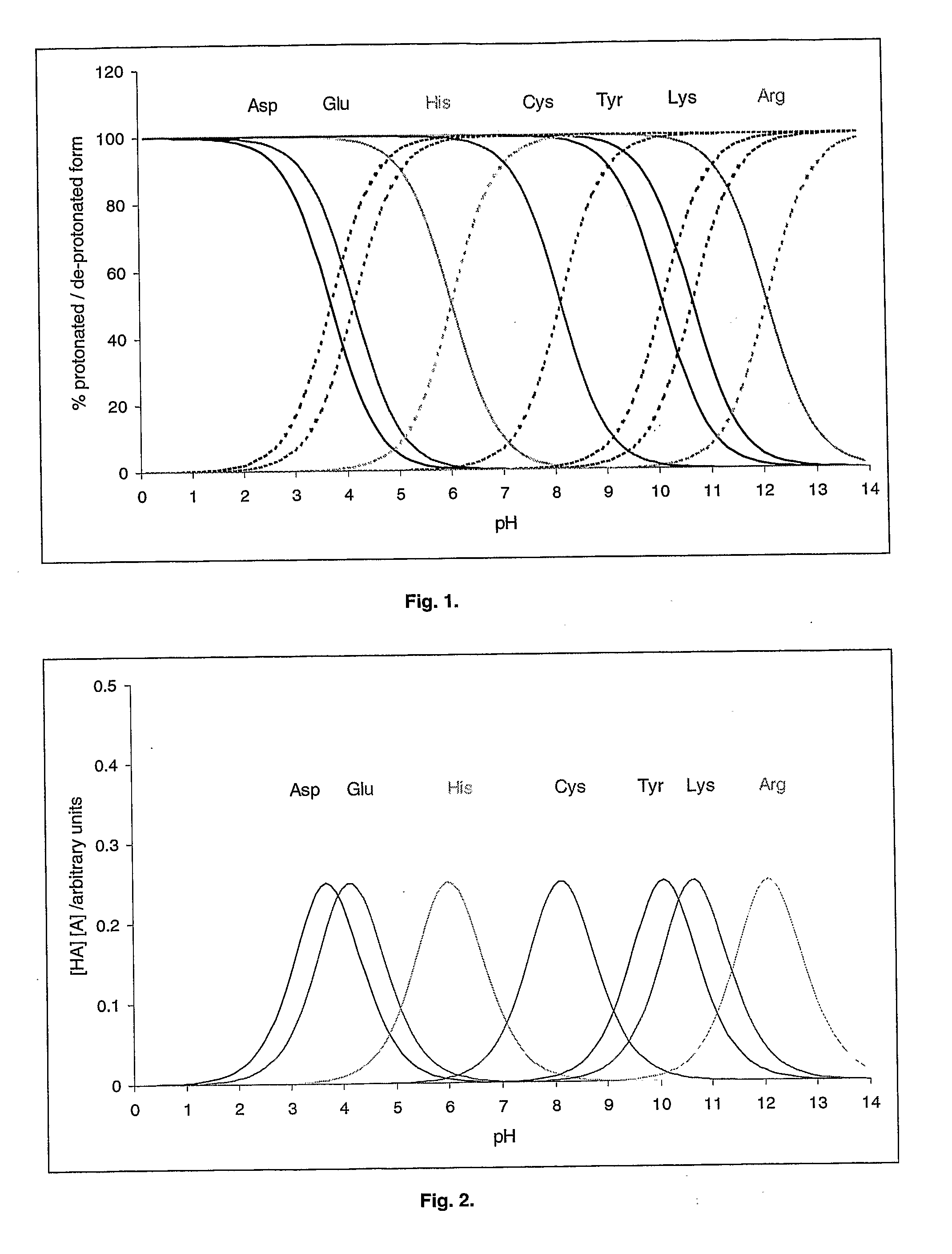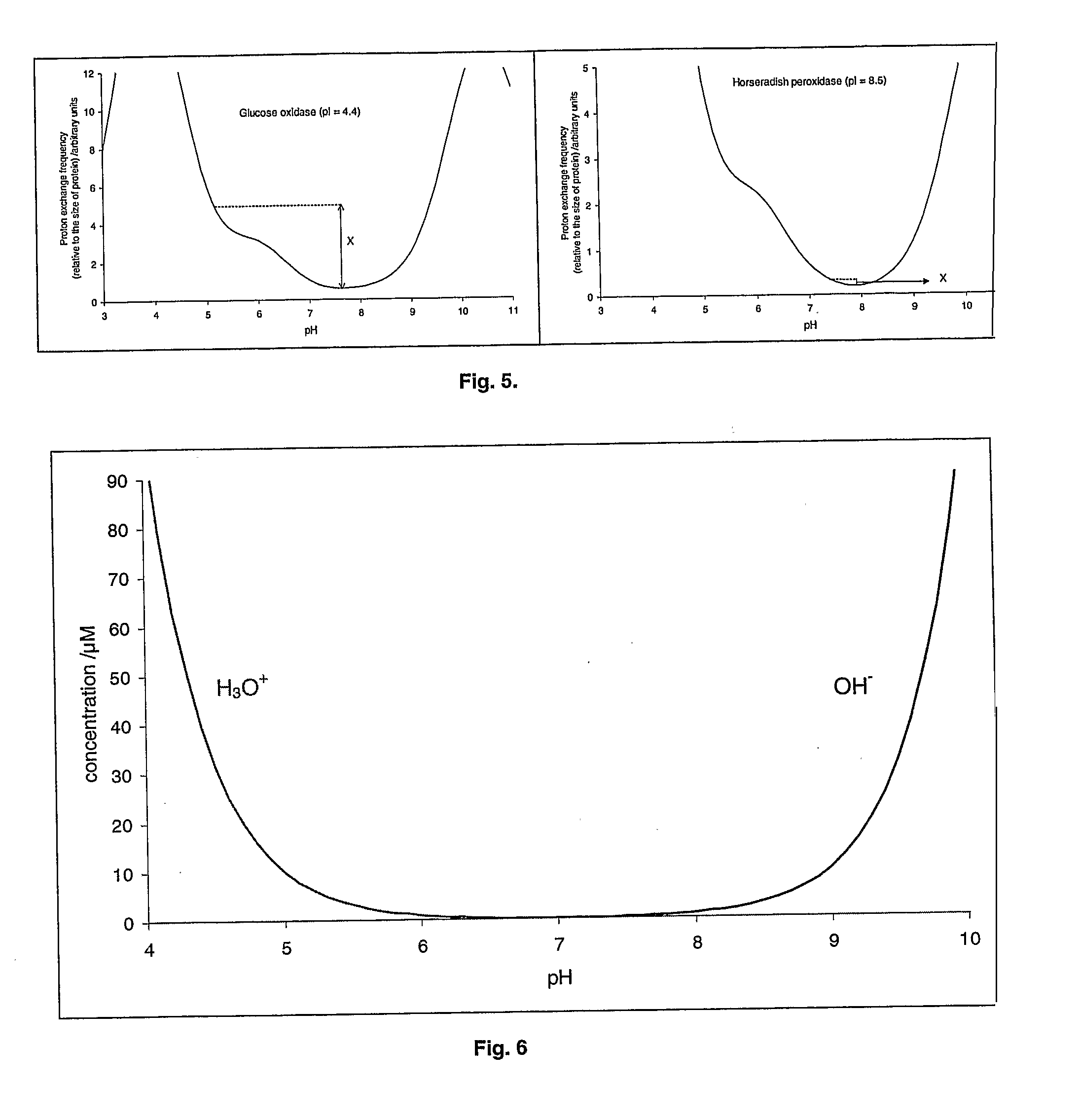Stable Aqueous Systems Comprising Proteins
a technology of stable aqueous systems and proteins, which is applied in the direction of antibody medical ingredients, peptide/protein ingredients, immunological disorders, etc., can solve the problems of stability problems in the storage of proteins for any length of time, and achieve the effect of improving storage stability, ensuring stability, and general improvement of storage stability
- Summary
- Abstract
- Description
- Claims
- Application Information
AI Technical Summary
Benefits of technology
Problems solved by technology
Method used
Image
Examples
example 1
Glucose oxidase (from Penicillium sp.)
[0215]Glucose oxidase (from Penicillium sp.) consists of two identical subunits (Mr of each approx. 80,000). The isoelectric point of glucose oxidase as approximately 4.3. The abundance of the acid-base amino acids in each subunit is shown in Table 4.
TABLE 4Number of side-chainsTotal number of side-chains inexposed at the subunitAmino acidthe subunitsurfaceAspartic acid (D)3623Glutamic acid (E)2317Histidine (H)83Cysteine (C)1 (3)*0Tyrosine (Y)196Lysine (K)2721Arginine (R)1711*The first number indicates the number of cysteines that are not engaged in disulphide bond. The number in brackets indicates the total number of cysteines in the subunit.
[0216]The proton exchange frequency profile for glucose oxidase is shown in FIG. 8. The pH optimisation algorithm gives the following results for glucose oxidase:[0217]Pminimum=0.17 (at pH 7.7)[0218]X=4.33[0219]Y=4.50[0220]Estimated pH optimum=5.0
[0221]Glucose oxidase solutions, both fresh and after incubat...
example 1.1
Poor Activity Recovery on Incubation of Glucose Oxidase Outside of the Calculated pH Optimum in the Absence of Beneficial Additives
[0227]The effect of 50 mM phosphate buffer (pKa=7.2) on the stability of glucose oxidase at 60° C. was investigated in the pH range 6.0 to 8.0. The phosphate buffer was prepared by mixing di-sodium hydrogen orthophosphate (50 mM) and sodium dihydrogen orthophosphate (50 mM) to achieve the required pH. There was no measurable activity following incubation of glucose oxidase at 60° C. for 15 minutes in the presence of phosphate at pH 7.0, 7.5 or 8.0. Some activity was measurable at 15 min at pH 6.5 and 6.0, but this fell to zero in 60 minutes. Better recovery of glucose oxidase activity was observed in deionised water. Nevertheless, even in this case the activity fell to zero after 180 min. The pH of glucose oxidase solution in Dl water was approximately 6. This is the result of the buffering ability of the enzyme itself and of the impurities in the enzyme...
example 1.2
Poor Activity Recovery on Incubation of Glucose Oxidase Outside of the Calculated pH Optimum in the Presence of Beneficial Additives
[0228]The effect of 50 mM TRIS buffer (pKa=8.3) in the presence of lactic acid on the stability of glucose oxidase at 60° C. was investigated in the pH range 7.5 to 9.0. Tris buffer was prepared by mixing Tris base (50 mM) and lactic acid (50 mM) to achieve the required pH. There was no measurable activity following incubation of glucose oxidase at 60° C. for 15 minutes in the presence of TRIS / lactate at pH 7.0, 7.5, 8.0, 8.5 or 9.0. The recovery of the activity was poor in spite of the presence of beneficial additives. This is because the pH was far out from the calculated pH optimum.
PUM
| Property | Measurement | Unit |
|---|---|---|
| pKa | aaaaa | aaaaa |
| pKa | aaaaa | aaaaa |
| pKa | aaaaa | aaaaa |
Abstract
Description
Claims
Application Information
 Login to View More
Login to View More - R&D
- Intellectual Property
- Life Sciences
- Materials
- Tech Scout
- Unparalleled Data Quality
- Higher Quality Content
- 60% Fewer Hallucinations
Browse by: Latest US Patents, China's latest patents, Technical Efficacy Thesaurus, Application Domain, Technology Topic, Popular Technical Reports.
© 2025 PatSnap. All rights reserved.Legal|Privacy policy|Modern Slavery Act Transparency Statement|Sitemap|About US| Contact US: help@patsnap.com



